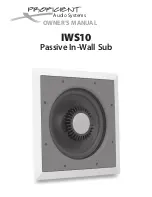
Proficient’s IWS10 In-Wall Subwoofer is designed to maximize the
listening experience in a home theater or distributed audio system.
Reading this manual will help you understand the importance of
placement and crossover calibration, that the optimal balance of
volume, frequency response and dispersion can be achieved.
Placing the IWS10 within 3 feet of a corner in the room will result
in increased bass output at frequencies that may be desirable
for home theater use. Placement beyond that point will result in
smoother, more even bass performance, which is more suitable
for music. Ultimately, the best placement of the IWS10 subwoofer
is one that allows it to produce a neutral, uncolored sound.
The IWS10 is conservatively rated at 250 watts of power handling,
the frequency response 36Hz to 150Hz. (A 250-watt amplifier with
installer-adjustable crossover is coming from Proficient; dealers
will receive product information as it’s made available.)
It’s important that a quality amplifier-crossover combination be
used for precise detail and a smooth transition from the low fre-
quencies of the other speakers down into the sub-bass range. As
a Proficient installer, you’ll be able to preset the crossover for just
the right pass point.
When connecting the IWS10 to the LFE or subwoofer out of an
A/V receiver, follow the receiver manufacturer’s instructions for
crossover adjustment. The size of the woofers in the system’s front
left and right speakers will dictate the choice of the best cross-
over point in the receiver. The larger the woofers, the lower the
adjustment. When making the adjustment, it’s best to listen either
to music you’re familiar with or the test tones from the receiver.
However, in some receivers the selection of certain surround
modes automatically switches the crossover to a default point.
INSTALLATION CONSIDERATIONS
2
SAFETY INSTRUCTIONS
• Explanation of Graphical Symbols
1. Read Instructions:
All the safety and operating instructions should be read before
the appliance is operated.
2. Retain Instructions:
The safety and operating instructions should be retained for
future reference.
3. Heed Warnings:
All warnings on the appliance and in the operating instructions
should be adhered to.
4. Follow Instructions:
All operating and other instructions should be followed.
5. Water and Moisture:
The appliance should not be used near water – for example,
near a bathtub, washbowl, kitchen sink, laundry tub, in a wet basement, or near a
swimming pool, etc.
6. Carts and Stands:
The appliance should be used only with a cart or stand that is rec-
ommended by the manufacturer.
PORTABLE CART
WARNING
7. Wall or Ceiling Mounting:
The appliance should be mounted to a wall or ceiling only
as recommended by the manufacturer.
8. Ventilation:
The appliance should be situated so that its location or position does
not interfere with its proper ventilation. For example, the appliance should not be sit-
uated on a bed, sofa, rug, or similar surface that may block the ventilation openings;
or placed in a built-in installation, such as a bookcase or cabinet that may impede the
flow of air through the ventilation openings.
9. Heat:
The appliance should be situated away from heat sources such as radiators,
stoves, or other appliances that produce heat.
10. Power Source:
The appliance should be connected to a power supply only of the
type described in the operating instructions or as marked on the appliance.
11. Power-Cord Protection:
Power-supply cords should be routed so that they are not
likely to be walked on or pinched by items placed upon or against them, paying
particular attention to cords at plugs, convenience receptacles, and the point where
they exit from the appliance.
12. Cleaning:
The appliance should be cleaned only as recommended by the manufacturer.
13. Nonuse Periods:
The power cord of the appliance should be unplugged from the
outlet when left unused for a long period of time.
14. Object and Liquid Entry:
Care should be taken so that objects do not fall into and
liquids not spilled into the inside of the appliance.
15. Damage Requiring Service:
The appliance should be serviced by qualified service
personnel when:
a.
The power-supply cord or the plug has been damaged; or
b.
Objects have fallen onto, or liquid has been spilled into the appliance; or
c.
The appliance has been exposed to rain; or
d.
The appliance does not appear to operate normally or exhibits a marked
change in performance; or
e.
The appliance has been dropped, or the cabinet damaged.
16. Servicing:
The user should not attempt to service the appliance beyond those
means described in the operating instructions. All other servicing should be
referred to qualified service personnel.
17. Grounding or Polarization:
The precautions that should be taken so that the
grounding or polarization means of an appliance is not defeated.
The lightning flash with arrowhead symbol,
within an equilateral triangle, is intended to alert
you to the presence of uninsulated “dangerous
voltage” within the product’s enclosure that may
be of sufficient magnitude to constitute a risk of
electric shock to persons.
The exclamation point within an equilateral tri-
angle is intended to alert you to the presence of
important operating and maintenance (servicing)
instructions in the literature accompanying the
appliance.
APPLICABLE FOR USA, CANADA OR WHERE
APPROVED FOR USAGE
CAUTION:
TO PREVENT ELECTRIC SHOCK, MATCH
WIDE BLADE PLUG TO WIDE SLOT, INSERT FULLY.
ATTENTION:
POUR EVITER LES CHOCS ELECTRIQUES,
INTRODUIRE LA LAME LA PLUS LARGE DE LA FICHE
DANS LA BORNE CORRESPONDANTE DE LA PRISE ET
POUSSER JUSQU AU FOND.
CAUTION:
To reduce the risk of electric
shock, do not remove cover (or back).
No user-serviceable parts inside. Refer
servicing to qualified service personnel.






















